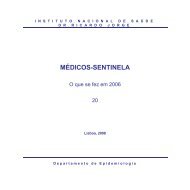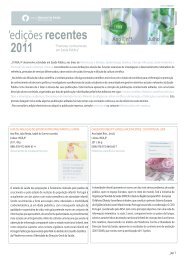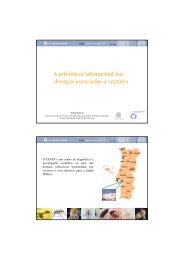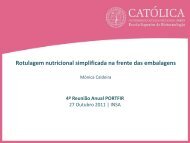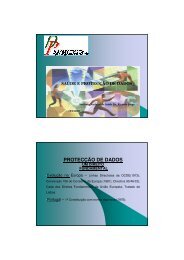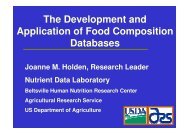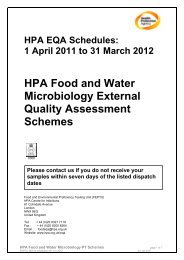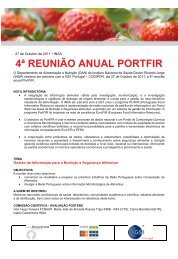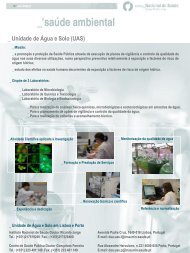European Society of Mycobacteriology - Instituto Nacional de Saúde ...
European Society of Mycobacteriology - Instituto Nacional de Saúde ...
European Society of Mycobacteriology - Instituto Nacional de Saúde ...
You also want an ePaper? Increase the reach of your titles
YUMPU automatically turns print PDFs into web optimized ePapers that Google loves.
IDENTIFICATION OF NONTUBERCULOUS MYCOBACTERIA<br />
IN CLINICAL SAMPLES USING MOLECULAR METHODS: A THREE-YEAR STUDY<br />
PP-55<br />
Isabel Couto 1,2* , Diana Machado 1 , Miguel Viveiros 1,3 , Liliana Rodrigues 1,4 and Leonard Amaral 1,3,4<br />
1 - Unit <strong>of</strong> <strong>Mycobacteriology</strong>, <strong>Instituto</strong> <strong>de</strong> Higiene e Medicina Tropical, Universida<strong>de</strong> Nova <strong>de</strong> Lisboa (IHMT/UNL), Lisbon, Portugal<br />
2 - Centro <strong>de</strong> Recursos Microbiológicos (CREM), Faculda<strong>de</strong> <strong>de</strong> Ciências e Tecnologia, UNL, Caparica, Portugal<br />
3 - COST ACTION BM0701 (ATENS)<br />
4 - UPMM, IHMT/UNL, Lisbon, Portugal<br />
Although Mycobacterium tuberculosis, the etiologic agent <strong>of</strong> human tuberculosis is the main cause <strong>of</strong> mycobacteriosis in<br />
Man, other species <strong>of</strong> mycobacteria may also cause infection in humans. The increasing importance <strong>of</strong> nontuberculous<br />
mycobacteria (NTM) is now consensually recognized and <strong>de</strong>mands for faster methods for their i<strong>de</strong>ntification and selection<br />
<strong>of</strong> appropriate therapy. In this work we report our experience on the i<strong>de</strong>ntification <strong>of</strong> NTM received from 12<br />
hospitals <strong>of</strong> the Lisbon Health Region (Portugal) over a three-year period using the GenoType Mycobacterium (CM/AS)<br />
assays (HAIN Lifescience). From 1 January 2005 to 31 December 2007, our laboratory received a total <strong>of</strong> 1192 acid-fast<br />
bacilli (AFB) positive isolates from 1174 patients presenting with presumptive active mycobacteriosis. All isolates were<br />
processed for Ziehl-Neelsen staining and inoculated into MGIT tubes <strong>of</strong> the BACTEC MGIT 960 system. M. tuberculosis<br />
isolated from culture were i<strong>de</strong>ntified by the Accuprobe system (Gen-Probe). Full-grown AFB cultures, negative for M.<br />
tuberculosis, were i<strong>de</strong>ntified by GenoType Mycobacterium (CM/AS) kits. Out <strong>of</strong> the 1192 specimen received, 1181 were<br />
i<strong>de</strong>ntified as members <strong>of</strong> the Mycobacterium genus. From these, 1032 cultures (87.4%) were positive for M. tuberculosis<br />
complex. The remaining 149 cultures were NTM, corresponding to 12.6% <strong>of</strong> the total number <strong>of</strong> cultures from which<br />
mycobacteria were isolated. During the study period, NTM prevalence increased steadily, starting with 8.7% in 2005 and<br />
rising to 15.2% in 2007. The joint use <strong>of</strong> the CM and AS kits i<strong>de</strong>ntified 96.6% <strong>of</strong> all NTM isolates tested. Among the 18<br />
NTM species i<strong>de</strong>ntified, M. avium complex was the most frequent, although it accounted for only 34% <strong>of</strong> all NTM. In<br />
countries with high inci<strong>de</strong>nce <strong>of</strong> tuberculosis and, particularly, multidrug resistant tuberculosis (MDRTB) such as Portugal,<br />
therapeutic failure with isoniazid and rifampicin is anticipated to be due to an MDRTB strain. Since many NTM species<br />
are resistant to these drugs, the i<strong>de</strong>ntification <strong>of</strong> the mycobacteria causing therapeutic failure (MDRTB versus NTM) is <strong>of</strong><br />
major importance. The introduction <strong>of</strong> molecular methods for the i<strong>de</strong>ntification <strong>of</strong> NTM in our laboratory has resulted<br />
in an increased awareness <strong>of</strong> the importance <strong>of</strong> being able to rapidly i<strong>de</strong>ntify NTM as potential pathogens and the key<br />
role played by the laboratory in assisting the selection <strong>of</strong> therapeutic modality.<br />
<strong>European</strong> <strong>Society</strong> <strong>of</strong> <strong>Mycobacteriology</strong> | 30 th Annual Congress | July 2009 | Porto - Portugal<br />
127



